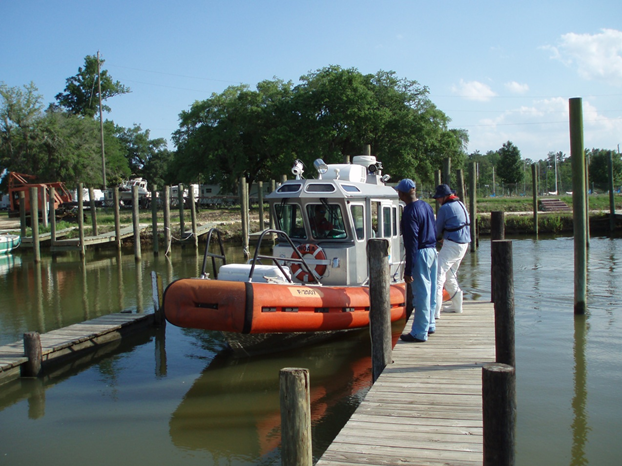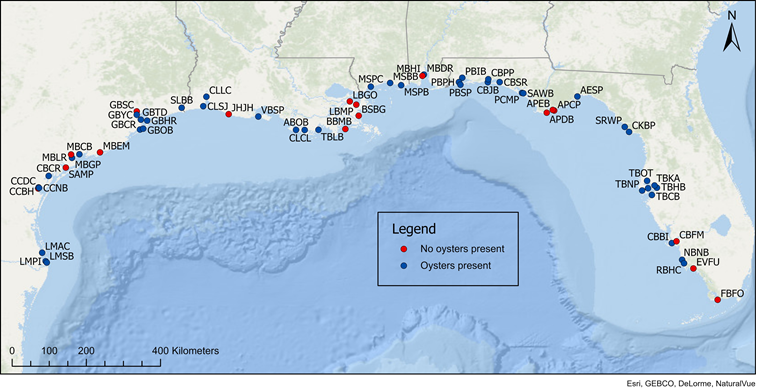
Mussel Watch team preparing to load supplies on NOAA small boat for sampling. Credit: NOAA.
The Mussel Watch Program has monitored the nation’s coastal waters for chemical contaminants since 1986 and in recent decades has expanded its monitoring to include trace metals, legacy contaminants, and contaminants of emerging concern (CECs). In 2017, the Mussel Watch Program collected oyster (Crassostrea virginica) samples from a network of 44 sites in the Gulf of Mexico. Results from this study will support a better understanding of the sources, fate, and transport of contaminants in the region and will fill important data gaps for local stakeholders.
Why We Care
The physiography, climate, and hydrology in the Gulf of Mexico provide natural conditions that support a rich and abundant diversity of plant and animal communities. The Gulf of Mexico region also supports highly productive fishing and shrimping, petrochemical, energy, tourism, aerospace, biomedical research, and agricultural industries. Thousands of chemical contaminants from many land-based point and nonpoint sources accumulate in the Gulf of Mexico every day, compromising water quality and, consequently, threatening human and ecosystem health.
Previous studies in the region have investigated legacy contaminants, such as trace elements and persistent organic pollutants (e.g., polychlorinated biphenyls (PCBs), organochlorine pesticides, chlordane, and polycyclic aromatic hydrocarbons (PAHs)). These research and monitoring efforts have helped managers limit the impact that legacy contaminants have on coastal ecosystems, but such efforts are lacking for the increasing number of new and unregulated compounds known as contaminants of emerging concern (CECs), many of which are known to be harmful to people, animals, and the environment. In response to resource managers’ concerns about the extent and impact of these chemical stressors, the Mussel Watch Program conducted a basin-wide survey in 2017 to assess the magnitude and distribution of a suite of CECs, metals, and legacy contaminants in the Gulf of Mexico.
What We Are Doing
The Mussel Watch Program uses an ecosystem-based approach to monitoring, which entails measuring the concentration of chemical contaminants in sediments and the tissues of indigenous bivalves, such as oysters and mussels, as a way to evaluate local environmental quality. Bivalves are used as indicator organisms for chemical pollution because they tend to bioaccumulate contaminants from the large amounts of water they filter, they have limited mobility, and they are found throughout the U.S. coastal zone.
The program currently analyzes sediment and bivalves for both legacy contaminants and CECs. Legacy contaminants, monitored by Mussel Watch since 1986, include compounds such as chlordanes, chlorobenzenes, dichlorodiphenyltrichloroethane (DDT), dieldrins, endosulfans, hexachlorocyclohexanes (HCHs), butyltins, PAHs, and PCBs. The monitoring of CECs began in 2009 and includes contaminants such as alkylphenols, alternative flame retardants, current-use pesticides, (per- and polyfluoroalkyl substances (PFASs), polybrominated diphenyl ether (PBDEs), polybrominated biphenyls (PBBs), and pharmaceuticals and personal care products. In general, CECs are minimally regulated, not commonly monitored, but potentially toxic chemicals that are finding their way into the environment.
In 2017, Mussel Watch analyzed sediment and oyster (Crassostrea virginica) samples from a network of 61 sites in the Gulf of Mexico for metals, legacy contaminants, and CECs. Although 61 sites from the region were identified to be sampled across the coastlines of the five Gulf states (FL, AL, MS, LA, TX), only 44 sites yielded enough oysters for laboratory analyses due to site accessibility and oyster abundance at historic locations. The National Mussel Watch Program 2017 Gulf of Mexico chemical stressors field survey was contracted to and conducted by TDI Brooks International.
Benefits of Our Work
This study supplies much-needed data to the national Mussel Watch Program and to local stakeholders and managers in the Gulf of Mexico region and informs water quality data used by coastal resource managers to develop effective, long-term policies to protect ecosystem services provided by the Gulf of Mexico.

Map of sites sampled in the Gulf of Mexico in 2017 as part of the NOAA Mussel Watch Program. Credit: Lauren Swam, NOAA.
 Official websites use .gov
A .gov website belongs to an official government organization in the United States.
Official websites use .gov
A .gov website belongs to an official government organization in the United States. Secure .gov websites use HTTPS
A lock or https:// means you’ve safely connected to the .gov website. Share sensitive information only on official, secure websites.
Secure .gov websites use HTTPS
A lock or https:// means you’ve safely connected to the .gov website. Share sensitive information only on official, secure websites.